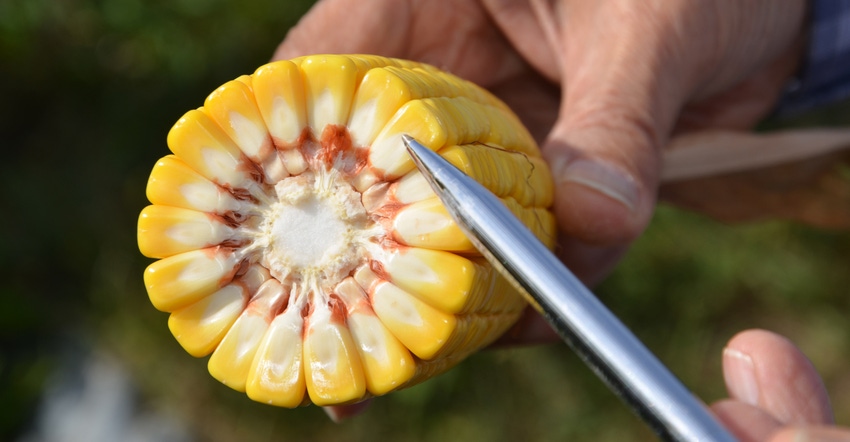
If you don’t routinely do field checks before harvest or work with a seed rep or crops consultant who does them for you, you may be missing out on valuable information. Some of what you learn can help you make storage planning and marketing decisions for the year. Other information could feed into your hybrid selection and planning process for the next year.
Kevin Peterson says preharvest field checks are an important service he provides for customers. He’s a seedsman for Channel Seed, serving growers in about a 40-mile radius from his home base north of Williamsport, Ind.
“Channel has a preharvest protocol, and we visit as many fields as we can, getting a handle for what the crop is like in each field we enter,” Peterson says. When he conducts preharvest checks, he does everything from evaluating how well pollination occurred to estimating yield.
“We’re also looking at plant health and stalk integrity,” he says. “For yield checks, we use the standard method outlined in the Purdue University Corn & Soybean Field Guide. We pick out 1/1,000-acre locations at random, then count ears, shuck individual ears at random, and count rows of kernels and kernels per row to get the data we need to estimate yield.”
Jeff Lakin, technical agronomist for Channel Seed, covers the northern half of Indiana, with 17 seed reps like Peterson reporting to him. “We usually advise our seedsmen to use 90 as the factor for kernels per bushel in the yield formula,” he says. “We realize we’re being conservative. If it’s a year with stress and kernels don’t fill out as well, the number may be closer to 100, meaning even 90 overestimates yield.
“If it’s a good year with lots of moisture and kernels fill well during grain fill, the factor might wind up closer to 70 to 80. We feel most comfortable going with 90.”
Peterson adds: “We tend to underestimate yield just a bit with these harvest checks, in most years using 90 as the factor. But we would rather be conservative than guess high, especially when growers are relying on our estimates for marketing decisions and for planning storage.”
More crop information
Many growers both Lakin and Peterson encounter use Climate’s FieldView software during the season. It collects data on field operations all season long.
“If they utilize FieldView and we find something interesting in the field we want them to know about, we can drop a pin there, and email it to them,” Peterson explains. “When they check the email, they can see what we saw. If it’s a problem area, the coordinates will help them go right to the spot so they can see it for themselves.”
Lakin says preharvest information collected during their checks can feed into custom crop reports for customers who use the information. “For example, if they have FieldView, after harvest they can pull up everywhere where they planted a certain hybrid,” he says. “If a hybrid is doing well in a field, or if, on the other hand, there is a performance issue, they can track and see how it performed in other fields, as well.
“Preharvest checks turn out a lot of information. How each grower uses it is up to them.”
About the Author(s)
You May Also Like




